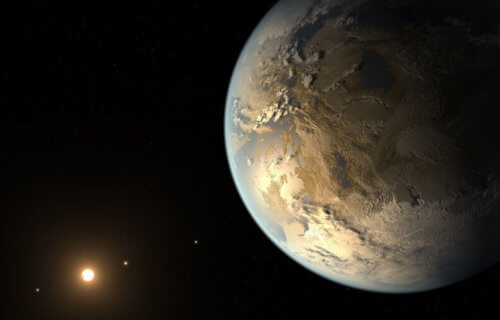BELFAST, Northern Ireland — As scientists chart the vastness of space, what will they find? Will there be mysteries and phenomena unlike anything humans have seen before? Or, could there be planets and life very similar to our own world? For the first time ever, astronomers have detected particles in the atmosphere of an exoplanet which are the same as those in Earth’s skies.
Researchers from Queen’s University Belfast say they discovered the new chemical signature from the Earth-like planet named WASP-33b. Using the high-powered Subaru Telescope, astronomers spotted hydroxyl radical (OH), one of the most common oxygen-bearing molecules at high temperatures.
“The discovery is the first direct evidence of OH in the atmosphere of a planet beyond the Solar System. It shows not only that astronomers can detect this molecule in exoplanet atmospheres, but also that they can now begin to understand the detailed chemistry of this planetary population,” says lead researcher Dr. Stevanus Nugroho, from the Astrobiology Center (ABC) in Japan and the School of Mathematics and Physics at QUB, in a university release.
What’s so special about OH?
In Earth’s atmosphere, researchers say OH is formed by a reaction between water vapor with atomic oxygen. The molecules act like an “atmospheric detergent” which filters out potentially deadly gases in the atmosphere like methane and carbon monoxide.
WASP-33b, however, is much different than Earth. It’s a much bigger and hotter planet than our home and its atmosphere also contains iron and titanium oxide gas. Study authors believe OH plays a major role in determining the overall consistency of that planet’s atmosphere. They add most of the OH in WASP-33b’s cloud layers likely comes from the destruction of water vapor due to the extremely hot temperatures there.
“We see only a tentative and weak signal from water vapor in our data, which would support the idea that the water is destroyed to form hydroxyl in this extreme environment,” Dr. Ernst de Mooij adds.
Finding ‘fingerprints’ in deep space
Along with the Subaru Telescope in Hawaii, researchers used an instrument called the InfraRed Doppler (IRD) to find OH in this planet’s atmosphere. IRD detects what the team calls “spectral fingerprints” of atoms and molecules. Specifically, it spots certain chemical features after superimposing them on the rainbow spectrum of light which distant stars and planets emit.
Researchers note that WASP-33b’s velocity in relation to Earth changes as it orbits its home sun. Just like an ambulance siren seemingly changing pitch as it speeds past you, the frequency of light creating these fingerprints changes with the exoplanet’s change in speed. The team explains that this allowed them to separate out WASP-33b’s signals from the ones from its home star.
“While WASP-33b may be a giant planet, these observations are the testbed for the next-generation facilities like the Thirty Meter Telescope and the European Extremely Large Telescope in searching for biosignatures on smaller and potentially rocky worlds, which might provide hints to one of the oldest questions of humankind, ‘Are we alone?’” concludes Professor Chris Watson, head of the Exoplanet Group within QUB’s Astrophysics Research Centre.
Previous studies have concluded that there may be as many as six billion Earth-like planets in our galaxy. Among those, a recent report singled out 24 nearby exoplanets which may actually be “more suitable” for life than our own world.
The study appears in the journal Astrophysical Journal Letters.
